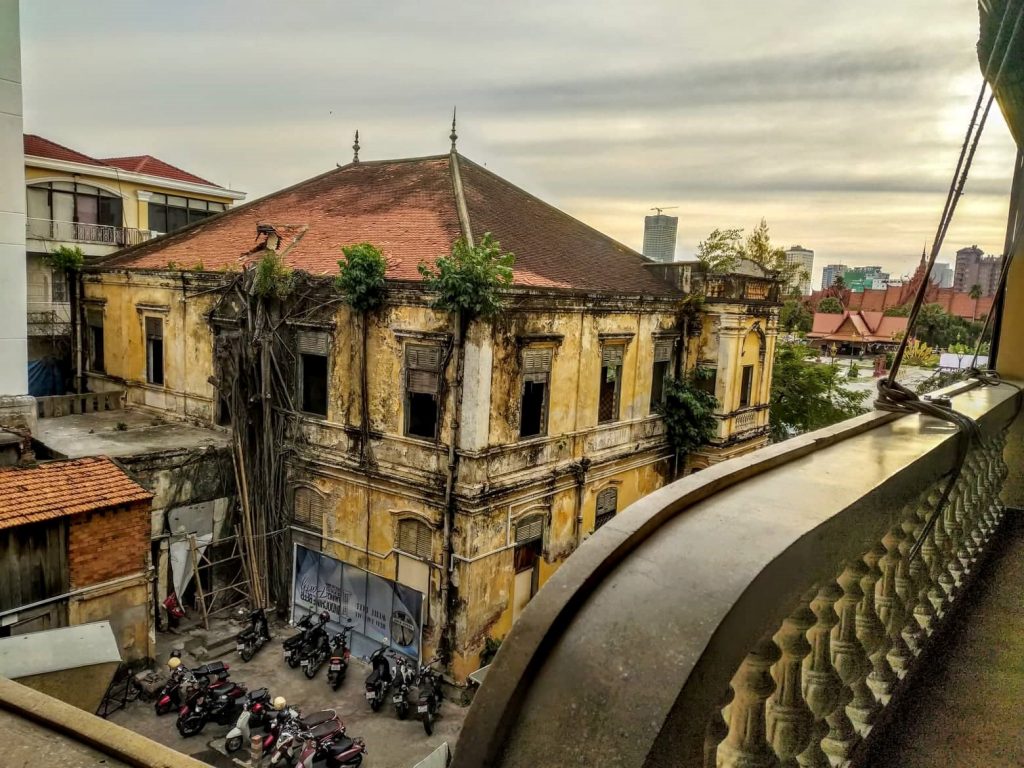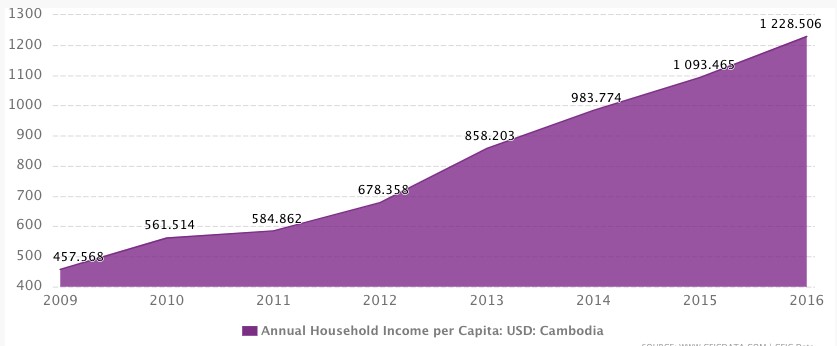Today I write to you from the Cambodian capital of Phnom Penh, sitting in a breezy table on the third floor of the FCC — Foreign Correspondents’ Club.
Since its earliest days, the FCC was the local watering hole for expats and journalists alike, legendary for the rich stories and tales told there.
On one side is the muddy Mekong River. As Asia’s aquatic super-highway, the river originates in the snowcapped mountains of Tibet…through China, Myanmar, Laos, Thailand, Cambodia and Vietnam… to its destination in the South China Sea.
Interestingly, this river is unique in the world as it changes the direction of its flow throughout the year…
On the other side of the FCC, beyond the decaying buildings of the colonial era, is the opulent Royal Palace complex that has housed the Kings of Cambodia since the mid-1800s.
 |
A dying mansion and the Royal Palace (Far right) | Source: Alison Kee |
Certainly flashier than our pale Premier House in Wellington, the Royal Palace is chock-full of silver adornments, gold flakes, and even a 66cm-tall jade Buddha.
It is an exposition of the lavish riches the country has to offer…and the few who hold power over it all.
Just beyond the ornate whitewashed walls of the Royal Palace, you’ll find the crowded back alleys of the riverfront district. Picture street-side markets covered in a patchwork canopy of multicoloured tarpaulins.
Beneath, sardined stalls teem with locals hawking grey catfish still flopping about on the wooden tables, second-hand electronics from the 1980s, and individual bottles of the local Angkor brew.
As you walk along the narrow ruts between the stands, you can’t help but wonder what nauseating cocktail of liquids is splashing up on your calves.
[openx slug=inpost]
Now, an ignorant response would be to stick one’s nose up…and write Cambodia off as just another lesser-developed country.
In fact, it’s one of the fastest-growing, most optimistic landscapes in the entire world today.
From an economist’s perspective, this emerging economy is on a remarkable trajectory…outclassing cruisers like China or India.
It’s long been known for its cheap labour force, used predominately by clothing and footwear companies like Gap, H&M or Adidas.
As a result, Cambodian households have experienced skyrocketing incomes…rising nearly 300% in less than 10 years, according to CEIC data.
 |
Source: CEIC Data |
If New Zealand had experienced that level of growth in the same time period, we’d be sitting pretty, with average household incomes easily over the $200k mark.
It means that many Cambodians have leapfrogged from toiling by hand in the rice paddies to owning apartments, scooters and cell phones…all in the past couple decades.
And we reckon that trend is going to continue to pick up in the years to come…if the country can adapt in one area — education.
As of now, most of the workers in the country are low-skilled. They do manual labour. Lots of it. Cheaply.
But it’s only a matter of time until robotics overwhelms that industry, starting with the lowest skilled, most automatable processes.
And robots will continue to take over, slowly making its way up the skill ladder.
Cambodians will need to stay ahead of that curve. They need move on from basic products like textiles…to more complicated manufacturing like electronics. Follow in the footsteps of Vietnam or China.
Then, from there, they’ll need to begin sliding into services like you see in India.
But to do that, they need education.
According to an entrepreneur I met here, most Cambodians have an education equivalent to the Form 1 level (or Year 7, by modern NZ school standards).
That’s not too different from what you’d find in many agricultural/low-skilled labour nations around the world.
You go to school until you’re big enough to help out on the farm or in the village factory.
But to advance in the years to come, they need future generations to learn more technical skills, as well as become linguistically relevant by learning Mandarin or English.
It’s an economic process we’ve seen before. So we know it’s doable. But Cambodia and other countries in Southeast Asia are on a deadline…as they’re outrunning the trend of automation.
If they fail…well, it’s hard to tell. We’ll be entering the terra incognita of economic theory. What do countries do when the stepping stone of manufacturing is removed from the equation?
As economist Jeffrey Sachs outlines in his book, The End of Poverty, there are four stages for a country like Cambodia to move through in order to pull itself up by its bootstraps.
The first (and worst) stage is what he calls the ‘perfect storm’. No international trade. Poor health. No domestic commerce. People living on a dollar a day. Think of countries like Malawi.
The second stage represents those countries ‘on the ladder of development’. They’ve tapped into international trade, but primarily through their cheap workers. You’ll see people living on a few bucks a day and working hard in sweatshops to earn it.
That’s roughly where Cambodia is today.
But soon, it’ll enter the stage of a ‘services revolution’. This is where people are educated enough to vie for internet/international jobs. Think India. They’ve got IT support teams and customer-service squads, all servicing Western companies. It’s getting its foot in the door of the developed world.
And lastly, Sachs points to China as a stage of ‘rising affluence’. Basically, it’s where all of the stages above come together — education, skilled labour, international trade — and usher in what we’d call a ‘middle class’.
I reckon Cambodia is still some way off from being the next China…but I wouldn’t be surprised to see it — and its Southeast Asian brothers — enter service revolutions in upcoming years.
It could mean a whole new range of opportunities for trade partners like New Zealand…
And that could trickle through to investors.
We’ll keep an eye on the story and keep you up-to-date!
Best,
Taylor Kee
Editor, Money Morning New Zealand





Taylor Kee is the lead Editor at Money Morning NZ. With a background in the financial publishing industry, Taylor knows how simple, yet difficult investing can be. He has worked with a range of assets classes, and with some of the world’s most thought-provoking financial writers, including Bill Bonner, Dan Denning, Doug Casey, and more. But he’s found his niche in macroeconomics and the excitement of technology investments. And Taylor is looking forward to the opportunity to share his thoughts on where New Zealand’s economy is going next and the opportunities it presents. Taylor shares these ideas with Money Morning NZ readers each day.